Introduction to Hue Vietnam – Hue City preserves the history, royal monuments, and intact romance to attract holidaymakers, history fanciers, and those who want to witness the 19th-century capital of the Nguyen Dynasty. While the city landscape remains idyllic with the laid-back lifestyle of the locals, the Citadel is well-preserved and ancient for the back-in-time tours to look back at the old time. Going through the ups and downs of history, the Complex of Hue Monuments was inscribed as a UNESCO World Heritage Site in 1993. Besides the must-visit historical monuments, Hue owns beautiful scenery and a romantic slow-paced lifestyle for any tired soul to refresh and revive. This is where you find no city bustle and hassle so that your vacation goes best in a peaceful way. The local food is also a magnet, of which Hue mussel rice or “Com Hen” is a must you should always savor. Also, the Hue food tours are the best-sellers that include live cooking classes. As one of the most praiseworthy historical cities in Vietnam, Hue serves as a giant “museum” for later generations to witness, study, and appreciate what the history left. Also, the romance and tranquility of the Perfume River are the great scores for a relaxing boat trip. The placid city has more to please guests, so if you still have some “WH” questions, keep reading this introduction to Hue to find the answers.
Overview of Hue
Hue is the capital city of Thua Thien Hue province in central Vietnam. In the past, Hue was the capital of Dang Trong (from 1738 to 1775) and the administrative capital of Vietnam under the Nguyen Dynasty (from 1802 to 1945). During the French Indochina period, Hue functioned as the administrative capital of the Annam protectorate. Nowadays, the city is dedicated to tourism by preserving the UNESCO-inscribed complex of Hue monuments. Tourists visit Hue not only because of the ancient royal monuments but also the romantic landscape and laid-back lifestyle of the Hue residents, which bring them peace of mind. Oftentimes, the tour to Hue is combined into the tour packages of Da Nang – Hoi An – Hue, which are best-sellers in recent times. The three destinations become the must-sees in central Vietnam. The two neighboring provinces of Hue are Da Nang and Quang Tri. In addition, Hai Van Pass connects Hue to Da Nang and serves as a border of climates between the two regions. Hue nowadays functions as the center of culture, tourism, medicine, and education in central Vietnam. Also, this city is a critical Buddhist center as its adjacent corners are filled with dozens of age-old Buddhist sites. It is the only city in Vietnam that retains the style of a medieval city and the intact architecture of a monarchy. Hue is a priceless “museum” for all of us to witness and appreciate.
Geographical Location
In central Vietnam, Hue City is located on the banks of the Perfume River, a few miles inland from the East Sea. The city of Hue is around 700km south of Hanoi, and 1,100km north of Ho Chi Minh City (Saigon). About its borders, Hue is encompassed by Quang Dien District and the South China Sea to the north, Phu Vang District to the east, Huong Tra Town to the west, and Huong Thuy Town to the south. Also, it is around 105km from Da Nang city, 14km from Thuan An seaport and Phu Bai International Airport, and 50km from Chan May Port. As of 2021, Hue city has a total area of 265,99 square kilometers. In an overview, Hue is a plain area, with an average altitude of 3-4m above sea level. Though the area has some hills and low mountains, the plain is relatively flat and often flooded when facing large rainfall. Regarding the administrative divisions, Hue consists of 29 urban wards and 7 rural communes.
Weather Characteristics
Hue City has a tropical monsoon climate, with the typical two seasons of dry and rain. While the dry months are from February to August, the rainy months are from September to January (of which the flood season begins from October onwards). Hue features an average temperature of 35 Celsius degrees, but during the rainy season, it sometimes might drop as low as 10 Celsius degrees. So, if you ask about the best time to travel to Hue, it should be around March when the local weather is chilly and with less rain, which is perfect for groups with elders and kids.
When to travel to Hue
If you have an idea to get to Hue, it’s necessary to find out the most beautiful season. The city is filled with engaging attractions and yummy dishes. Therefore, if traveling to Hue during the favorable climate, you can conveniently explore the city without a need to worry about the occasional rain which interrupts and ruins the trip. In general, the best months to travel to Hue are from January to March, which is the springtime featuring a favorable climate.
- From January to March: The climate is favorable and chilly. The greenery becomes lush and fresh. This period is just perfect for contemplating the delicate beauty of Hue.
- April: This is the Hue Festival season when the atmosphere becomes dynamic and exhilarating. Also, the city streets are decorated with shining items. So, if you’re keen on the festival mood, get there in April.
- From May to August: This is the dry season in Hue when the weather can be quite scorching. So, if you get there in the hot climate, it’s smart to wear comfortable clothes.
- From September to December: These months feature the rainy season in Hue when the city often faces heavy rains and possible storms.
As the weather is a hard-to-exactly-predict subject, remember to check the weather forecast updates prior to your arrival. If you love the festival mood, let’s go in April. Other months are good to go too as per your preferences.
Hue History and Development
Located in central Vietnam and being one of the economic centers, Hue city is also a center of culture, tourism, and festival in Vietnam. It was the last feudal city of Vietnam, which was linked to its long-lasting history and royal culture. The history of Hue could be described as follows:
The Thuan Hoa-Phu Xuan regions
The old documents wrote that this region had existed under the reign of the Hung King. During the northern domination of the Han Dynasty, it belonged to Nhat Nam, one of the three wards of the Au Lac Country. In 192, it was of Lam Ap country, and then Champa kingdoms for the continuous 12 years. In 1306, after the marriage of the princess Huyen Tran, O-Ri sectors were transferred to the Tran Dynasty, who later changed them to Chau Thuan and Chau Hoa. In 1636, Lord Nguyen Phu Lan moved the capital to Kim Long, which was the beginning of the urban development of the region. A century later, in 1687, Lord Nguyen Phuc Thai transferred the capital to Thuy Loi, which was later renamed Phu Xuan, in the southwest of the present Citadel of Hue. Under the reign of Lord Nguyen Phuc Khoat, Phu Xuan developed into a prosperous capital city. Later, during the Tay Son empire (1788-1801), Phu Xuan remained the capital city of the Dai Viet country and the capital city of Vietnam for nearly 1,5 centuries under the Nguyen Dynasty (1802-1945).
There have been no exact records confirming the time when the name “Hue” was first used. Nonetheless, here is significant information:
- On 20 October 1989, Thanh Thai King ordered to establish Hue town. On 12 December 1929, the Hue town was leveled to Hue City.
- After the April Evolution, Hue included the urban and suburban regions, as the district of Thua Thien.
- In 1956, the Ngo Dinh Diem government performed administrative modifications, then Hue City was on the same level as Thua Thien.
- In 1975, Hue City consisted of 18 wards and 22 communes.
- In 1898, Hue became the city of Thua Thien Hue.
New era of Hue
From 1990 to 2010, Hue City went through several times of administrative divisions into many wards and communes. By early 2021, Hue city has 27 wards including An Cuu, An Dong, An Hoa, An Tay, Huong Long, Huong So, Kim Long, Phu Binh, Phu Cat, Phu Hau, Phu Hiep, Phu Hoa, Phu Hoi, Phu Nhuan, Phu Thuan, Phuoc Vinh, Phuong Duc, Tay Loc, Thuan Hoa, Thuan Loc, Thuan Thanh, Thuy Bieu, Thuy Xuan, Truong An, Vinh Ninh, Vy Da, and Xuan Phu. The expansion of Hue city was a milestone in the history of its formation and development and also a great opportunity for Hue to transform. Going through several times of administrative divisions and merges, Hue today has 29 wards and 7 communes. That could be said that Hue has been developing sustainably and correspondingly to its potential and position.
Whether it is the Capital, Citadel, Town, or City, Hue plays an important role as the center in various aspects. Nowadays, only after Hanoi and Ho Chi Minh City, Hue is a critical center of politics, culture, tourism, education, training, science, and technology in Vietnam. With the long records of history and royal culture during its formation and growth, Hue has formed its own identity, which attracts visitors domestically and internationally. People might refer to Hue with numerous beautiful names, such as the National Green City, the Festival City, the Romantic City, ASEAN Cultural City, and more.
Introduction to Hue Means of Transport
You can get to Hue by plane, train, and public coach. First of all, the plane is the most convenient and fastest way to reach Hue from other big cities namely Hanoi and Ho Chi Minh City. Most domestic airlines run direct flights to Phu Bai International Airport of Hue. The public coach and private car options are suitable for those who are staying in the nearby provinces like Da Nang. And, if you have abundant time and enjoy the long ride, then traveling by train to Hue might be an option; sightseeing the sceneries from the train windows is enjoyable and the train ticket is affordable.
To get around Hue, it’s super easy to choose a wide means of transport from the taxi, motorbike (if you can drive a motorbike with a valid license in Vietnam), motorbike taxi, cyclo, and rental car. Among these, the taxi is the popular choice for groups of travelers or when the weather is unfavorable. Besides, a cyclo trip toward the Dong Market and past the Truong Tien Bridge is a must-have experience. In case you want to combine several attractions into a Vietnam tour, it’s smart to rent a car (with a driver) to move between the sites.
Introduction to Hue’s Best Tourist Attractions
The Citadel of Hue
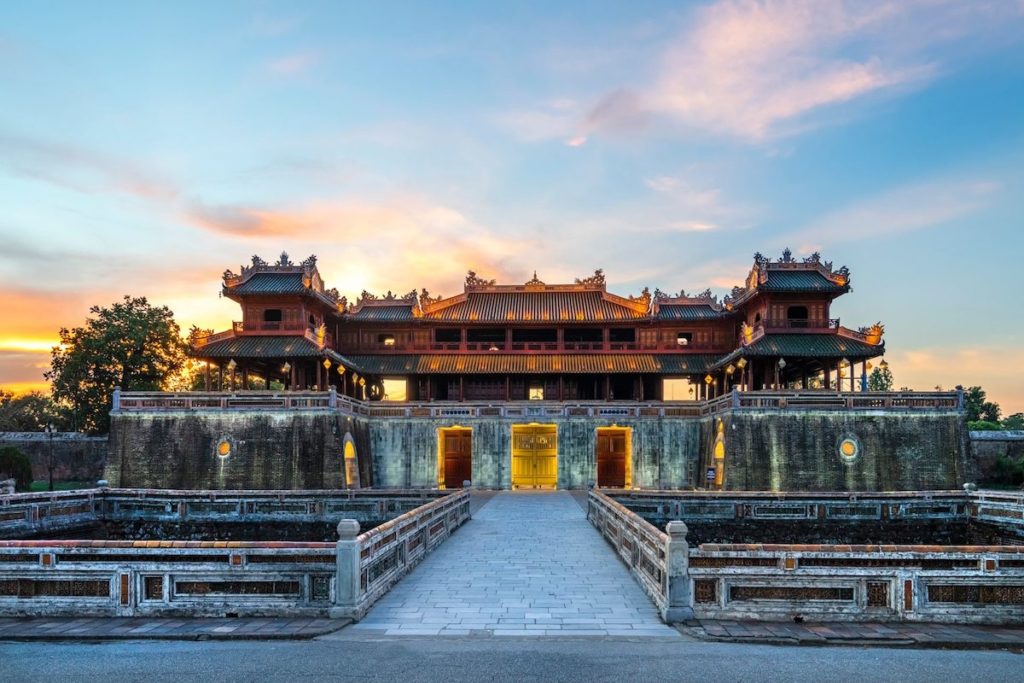
The Citadel of Hue is located on the northern bank of the Perfume River. It has an area of 500 hectares and three rampant circles: 1) Capital Citadel (Kinh Thanh), 2) Imperial City (Hoang Thanh), and 3) Forbidden City (Tu Cam Thanh). The royal complex was recognized as a UNESCO World Heritage Site in 1993. Exploring from the outside to the inside of the complex, tourists will visit the three rampant circles in sequence. Interestingly, the Forbidden City was once “forbidden” but is now open to tourism. In this royal spot, guests can try dressing like the Kings and the Queens for memorable photographs. The service’s cost is reasonable; with this, you receive instant pictures. Besides, you can pay more to have customized souvenirs like cups with your pictures printed on them. The Citadel is best for a walking tour where you can feel and touch the 19th-century relics and listen to the stories of the Nguyen Dynasty. In the past, the forbidden city was only accessed by the emperors, concubines, and their families. Those without the granted permission but tried to trespass would be punished to death. Today, the vast complex is open to all guests so you can admire the ancient moats, royal pavilions, galleries, and more. Wearing “Vietnamese Ao Dai” and taking pictures in front of the Citadel are the big musts. That said, Hue is home to Ao Dai and is where this kind of traditional Vietnamese dress can shine. If interested, you can further reach a local tailor shop and ask them to make your own “Ao Dai.”
Dong Ba Market
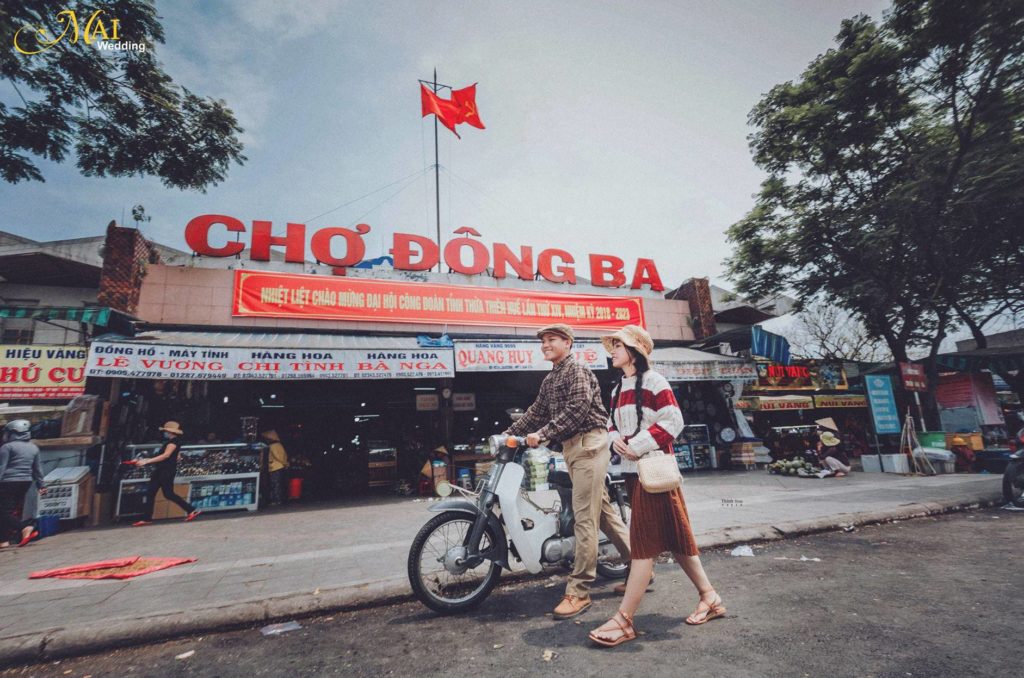
On a par with the Ben Thanh Market of Saigon and Dam Market of Nha Trang, the Dong Ba Market is a symbol of Hue. The market was opened under the reign of Emperor Gia Long and went through many ups and downs. Then, it was finally changed to Dong Ba Market in 1887 by Emperor Dong Khanh. Dong Ba is the oldest and largest wholesale market in Hue, where people find a myriad of local ingredients, fruits, and food. The market is also the ideal spot to watch the locals’ activities and trading vibe. You’re likely to come across many attractive street vendors that sell the local iconic dishes. A cyclo tour to the Dong Ba Market gives you precious opportunities to feel the idyllic and fresh atmosphere of Hue, which is hard to find in any other city. Make sure you have your camera fully charged to capture the riverscape, the chronicled Truong Tien Bridge, etc., before you reach this market.
Truong Tien Bridge

Truong Tien is a 402,60 m long bridge designed in Gothic architecture. It crosses over the Perfume River. The northern bridgehead is in Dong Ba ward while the southern bridgehead is in Phu Hoi ward. The bridge has a long history linked to the history of Vietnam and the French colonial era. In Festival Hue 2002, Trang Tien Bridge was installed with the modern color-changing electric system. In almost any Vietnamese literature about Hue, the name Trang Tien was incorporated. As a famous site, it has become a subject of many arts from poems to literature and songs. Nowadays, under the bridge, you can find many booths that sell souvenirs and there is a pedestrian night market filled with yummy food. When walking in the area, make sure you enjoy Trang Tien ice cream. Together with Dong Ba Market, Truong Tien Bridge is the iconic and historical image linked to the Hue identity.
The Perfume River
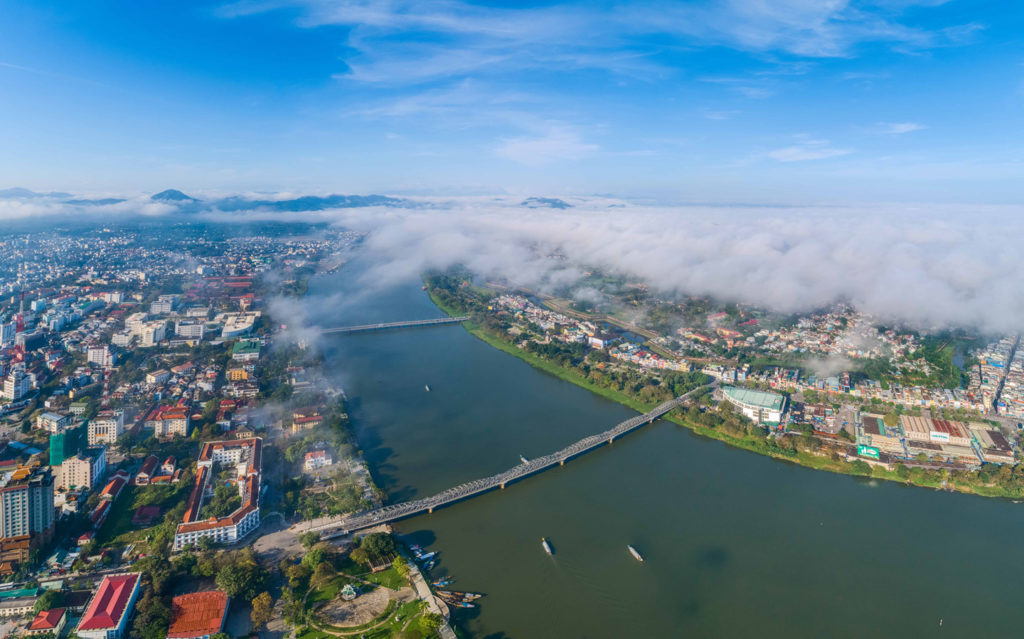
It is wonderful to promenade along the banks of the Perfume River, one of the most famous waterways in Vietnam. Another perfect option to enjoy the charm of the river is to take a boat trip in the evening. Oftentimes, the dinner cruise on the Perfume River also offers live performances of the local artists who are dressing the “Ao Dai” and singing the local songs. It is called the “Hue identity” which is hard to experience elsewhere. While the Perfume River is very scenic and calm, the Hue food and the local songs make up the great pastime at night. The name “Song Huong” has been linked to the Hue identity ensuring its position in the locals’ beliefs and tourism symbol of Hue.
Thien Mu Pagoda
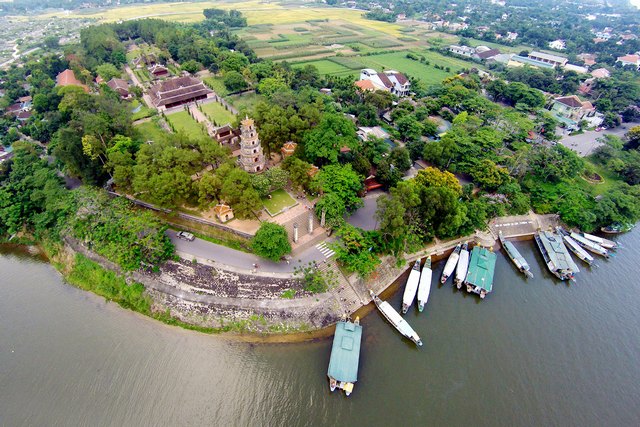
Thien Mu is the largest and most important pagoda in Hue. It is also the official symbol of the city. In any talk about Hue City, people won’t miss the name of the ancient Thien Mu Pagoda. The site has an irreplicable role in the locals’ beliefs. Make sure you won’t ignore the famous and important Thien Mu Pagoda (another name is Linh Mu), which is located on the hill of Ha Khe, on the left side of the Perfume River, Kim Long Ward, and is around 5km to the west of Hue City. The beautiful reflection of Thien Mu Pagoda appears peacefully on the Perfume River and has been a popular image for both locals and visitors who get there to pray for all the best. This was the oldest pagoda in Hue, founded around 1601. In any talk about Thien Mu Pagoda, people often think of the Phuoc Duyen Tower which was erected in 1844 by Emperor Thieu Tri. The tower was 21m high, in an octagonal shape, and had seven floors. Each floor was dedicated to worshipping a Buddha. In front of the tower is the Huong Nguyen shrine. From the tower, you can enjoy sightseeing the romantic Perfume River for precious peace of mind. Besides the historical, cultural, and spiritual values, Thien Mu Pagoda is also a symbol linked to the peaceful charm of Hue, which makes it a must to visit during any Hue Tour. A trip to Hue without a visit to Thien Mu Pagoda is an incomplete trip, agreed by numerous tourists.
Tomb of Emperor Khai Dinh
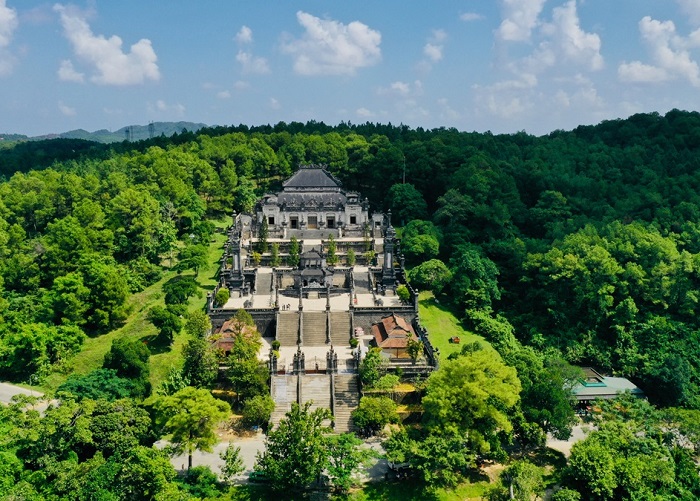
Situated along the Perfume River is a myriad of the kings’ tombs, namely the tombs of Minh Mang, Khai Dinh, and Tu Duc. Among these, the tomb of Emperor Khai Dinh stands out as a must-see with the impressive structure and interesting story linked. At the first sight, the gate to the tomb tells its ancient history and upon your arrival at the main ground, the stone statues of the mandarin soldiers provide a unique look. The construction was built from 1920 to 1931 and took 11 years to complete. It was a blend of Western and Eastern architecture. When getting inside the property, you will be astonished by the porcelain art carved in many details. Besides, the ceiling of the palace was adored by the nine intricate dragons. The rear room of the property contained a temple dedicated to Khai Dinh’s grave and his altar. History lovers should always include this palace on the list of attractions to see in Hue.
Tomb of Emperor Tu Duc
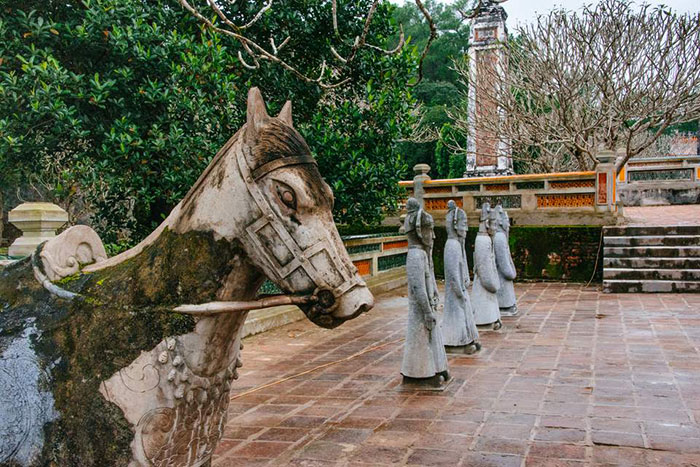
Also called “Khiem Mausoleum,” the Tomb of Emperor Tu Duc took three years to complete, from 1864 to 1867. The palace was divided into a temple and a tomb. Note that Emperor Tu Duc had the longest reign in the history of all monarchs of the Nguyen Dynasty; he ruled from 1848 to 1883. This means the tomb was planned and completed under his reign. Upon completion of the construction, the emperor used the tomb’s palace as his place of residence for the rest of his life. The retreat featured the pavilion and lotus pond where the Emperor Tu Duc enjoyed reclining, reciting, and composing poetry. The emperor even enjoyed the boat trip on the lake. In the tomb area, there were three tombs of Tu Duc, his son, and his primary wife. There have been stories about the emperor’s life, the location of his real tomb, and more, which will interest the modern tourists.
Tomb of Emperor Minh Mang
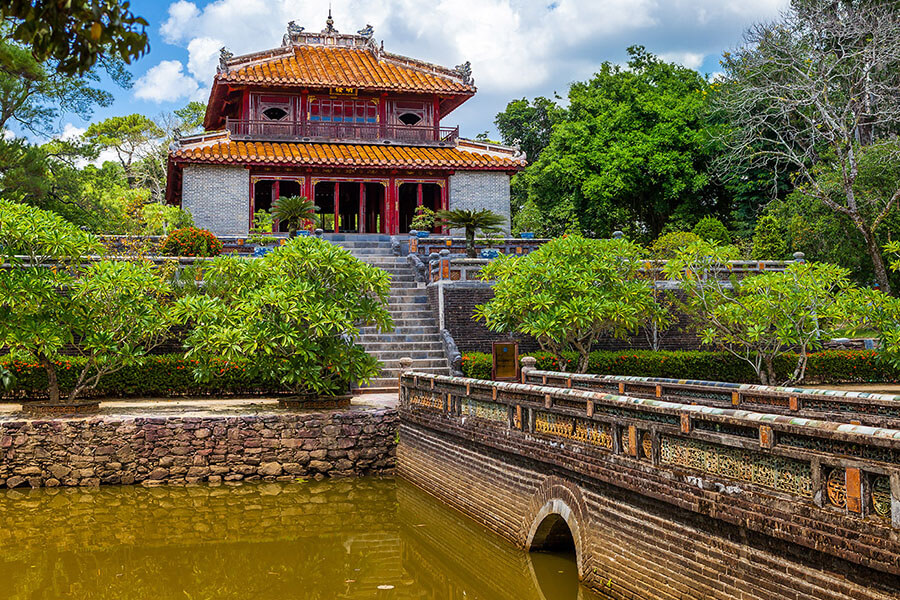
Around 14km from Hue City and situated in Cam Ke Mountain, Minh Mang Tomb (also called Minh Menh or Hieu Tomb-filial piety) was constructed under the reign of emperors Minh Mang and Thieu Tri, from 1840 to 1843. During the construction of the property, emperor Minh Mang passed away in 1841, then under the reign of Thieu Tri, the work was continued in accordance with the plan left by the emperor’s father. In 1843, the construction was complete, which transformed the wild hill into a sacred and solemn palace, which was outstanding in architecture, being friendly to nature, and reflected the deep ideological values. Together with a series of architectural works with aesthetic and artistic values, there preserve nearly 600 poems carved, which are priceless masterpieces to learn about the early 19th-century Vietnamese poems.
Phu Cam Cathedral
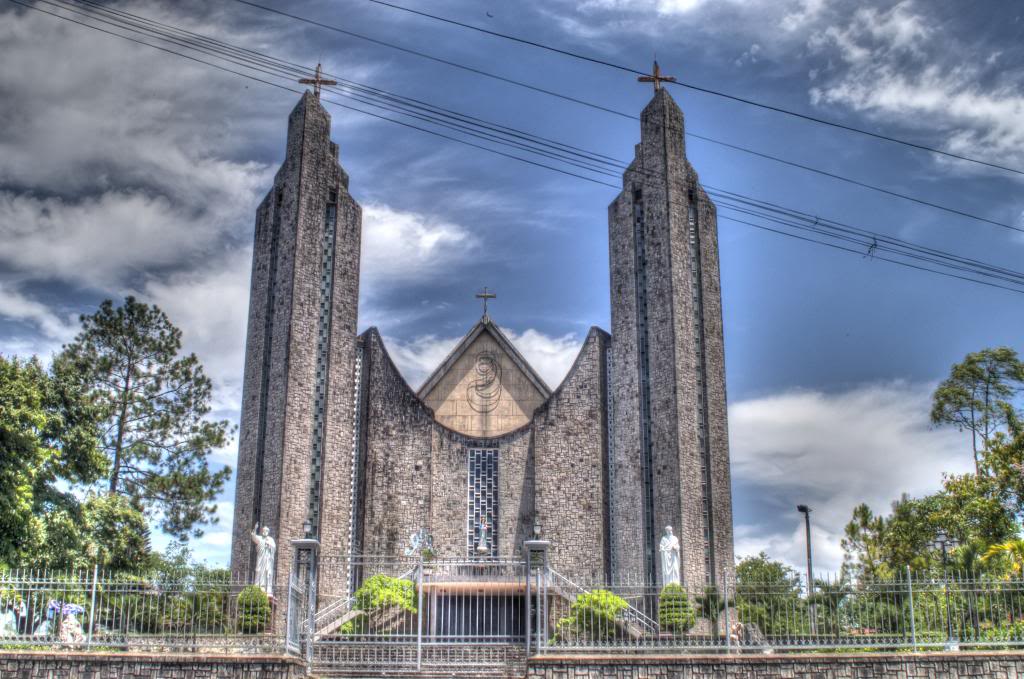
As one of the largest and oldest churches in Hue, Phu Cam Cathedral (Immaculate Heart of Mary Cathedral) is a must to visit if you’re seeking the best church to do your religion or just wanting to witness the 17th-century construction. The site is impressive with beautiful architecture, and two giant bell towers (of which each tower has 12 floors). The Cathedral looks eye-catching with the Western classic arts. During Christmas Eve, this church is a popular gathering place, and the parish also gives food and gifts to the poor. Erected on a hill, the Cathedral has a panoramic look. Historically, it took nearly 40 years (since 1963) to complete the constructions with some additions. All in all, if you ask for the top church in Hue, then Phu Cam is a place to visit.
Thuan An Beach
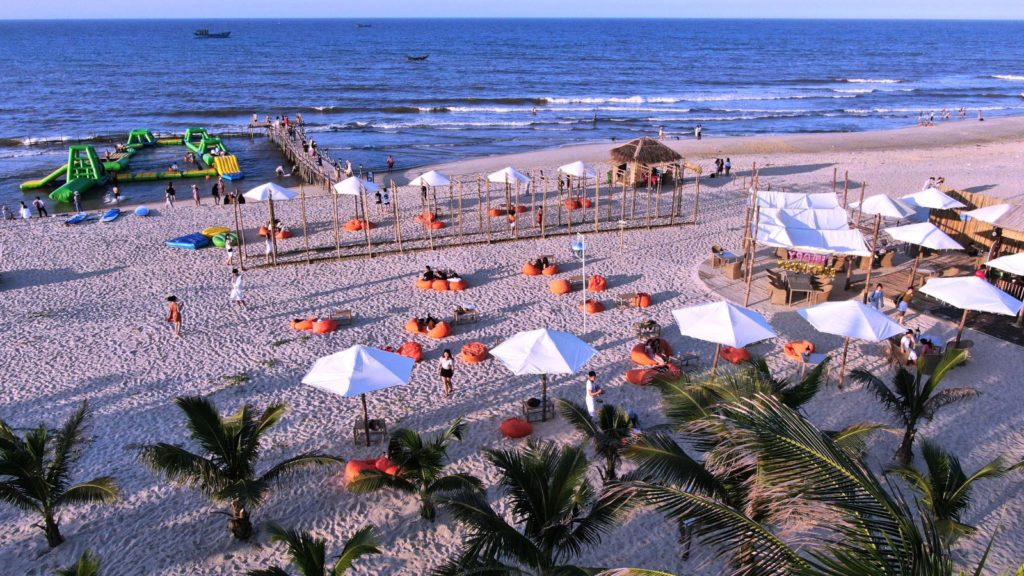
With the transparent blue water and soft white sandbank, the pristine Thuan An Beach is a natural highlight of Hue to enchant vacationers. The best time to arrive at this beach is in the early morning when you come across the busy fishing boats of the local fishermen. You can expect to meet the full-of-fish boats that sell the freshest seafood ever. The beach is around 15 km from the center of Hue City, which takes around a 20-minute ride. This is one of the most beautiful beaches in Hue for you to relax by the pristine nature, the white sandbank, and the crystal clear water. So, if you ask for the best months to go, let’s go to the beach around April to September every year. During these months, the beach is chilly and perfect for holidaymakers to relax, immerse themselves in the cool water, and enjoy a walk on the soft sandbank. Even the blue clear sky over Thuan An can help provide a wonderful background for photography. Next to the beach is the fishing wharf, in which you meet the fishermen and see how they transport the full-of-fish bags from the boats to the shore for selling. The dynamic atmosphere is very interesting to take part in.
Bach Ma National Park
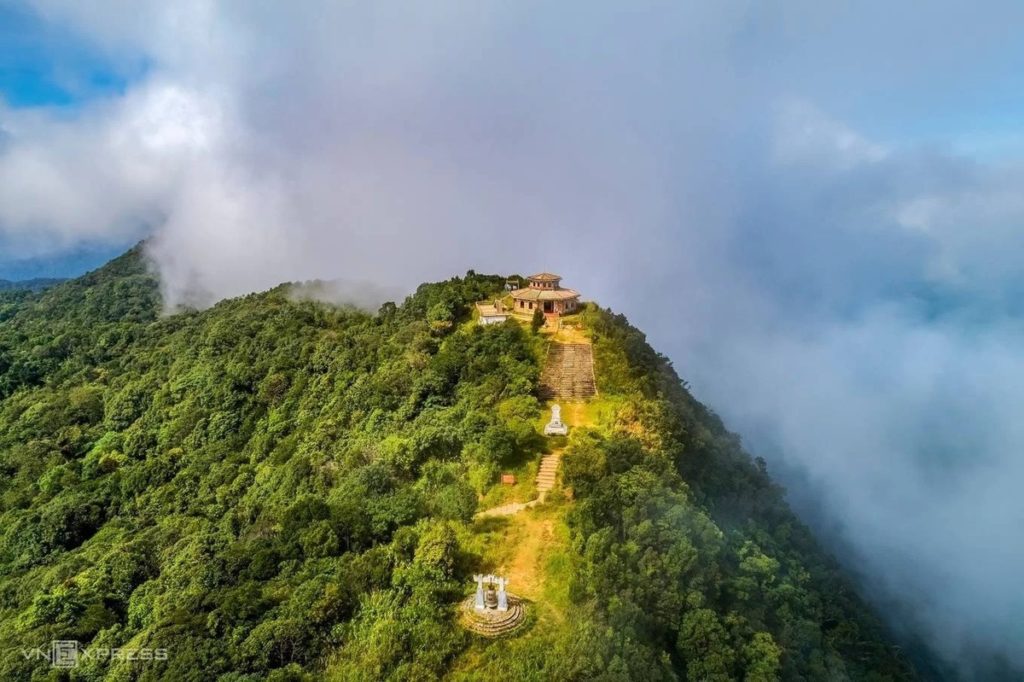
Around 40km from Hue City, Bach Ma National Park (also called Bach Ma – Hai Van) is an untouched ecotourism destination where you find the awesome off-the-beaten-track paths for the real treks. The park is also known for the exceptional systems of flora and fauna, the enchanting scenery, the picturesque waterfalls, primitive forests, etc., for trekkers to explore nature as well as the wildlife. Bach Ma National Park is set in the Truong Trung Son area, with the summit of Bach Ma Mountain at the height of 1,448m. Included in the park are several waterfalls, and in the east are the Cau Hai and Lang Co Lagoons. Nowadays, to serve the tourists, there are guesthouses and tourism trails in the park for nature-friendly expeditions on the spot. The not-to-miss highlights include the spectacular sightseeing, wildflower, age-old trees, primitive forest, Truc Lam Bach Ma monastery, and Ngu Ho Waterfall. During the eco-tours and camping in Bach Ma National Park, it feels like you’re getting lost in the distinctive terrestrial world which is fabulous, intact, and impressive.
Most of throughout Vietnam tours package includes Hue Imperial City in the itinerary:
Vietnam tour package 2 weeks
Vietnam tour package 3 weeks
Introduction to Hue’s Top Resorts and Hotels
Banyan Tree Lang Co Resort
For a royal-style honeymoon, couples are highly advised to spend nights in Banyan Tree Lang Co Resort which is located in the beautiful Lang Co Beach. The merits of ancient feel and modern design are well combined in this luxurious resort, which pleases guests at first look. You’ll be entertained by the all-pool villa among the gorgeous landscape. The royal dining served at this address makes it worth your money. The resort is bordered by cliffs, pristine beaches, and dense forest. It has the essentials of a spa, swimming pool, restaurant, Banyan Tree golf course, etc., which nurture your entertainment and comfort. Banyan Tree Lang Co Resort is number #1 in the list of the top resorts in Hue.
La Residence Hotel and Spa
La Residence Hotel and Spa appears luxuriously as an opulent property nearby the Imperial City of Hue. In the past, it was a mansion resided by high-ranking French officials but was damaged during wartime. The site was remodeled in an art deco design. Upon your stay, you’ll be pleased with viewing the colonial-era ceilings and the stained glass windows. In addition, a touch of luxury is presented in the facilities of the spa, gym, tennis court, and swimming pool. Merely the white mansion looks photogenic for your arts. The luxury suites are made in warm yellow and brown which creates a contradiction to the white and green colors of the building.
Vedena Lagoon Resort and Spa
In a royal style, Vedena Lagoon Resort and Spa is settled on the scenic Cau Hai Lagoon, which offers it a beautiful and fresh setting. Guests will be interested in staying at the gorgeous huts stretching out onto the water. The view from the resort towards the pristine and charming lagoon is the unbeatable highlight that only this place possesses. You’re likely to see the slim wooden boats floating peacefully on the water. The mountainous background is also perfect for photography all year round. You can opt for the rooms on the water or the ones elevated in the hills. The must-try services at this address are the enormous swimming pool and the relaxing yoga.
Imperial Hotel Hue
The massive Imperial Hotel Hue is where you can try living in regal splendor. The regal atmosphere is well presented in each detail. First of all, upon your arrival at the entrance and reception areas modeled by the traditional Vietnamese pavilion, you feel like stepping into the regal zone. Besides, the dining room surprises you with the outline of the awesome luxury of the imperial era. Visitors can happily spend day hours at the giant swimming pool and the King’s Panorama Bar in which no boring moment can exist. For the night time, the elegant and luxurious rooms nurture your sleep.
Hue Riverside Villa
The hotel is located on the bank of the calm and pretty Nhu Y River, which provides a nice river view from each room. Guests will be interested in watching the local fishermen’s activities. The friendly images of the local houses, fishermen, bamboo sampans, and especially the picturesque reflections on the river become valuable objects for your photographs. The rooms in Hue Riverside Villa are designed with Vietnamese style and architecture for a cozy and affordable stay. Hue Riverside Villa also runs motorbike tours toward nearby attractions like Hoi An and Phong Nha. This address has received a high ranking on TripAdvisor as most guests vote it the wonderful place to stay in Hue.
Beach Bar Hue
If you love beaches and prefer staying nearby Thuan An Beach, then Beach Bar Hue is a suitable accommodation to lay the head. Things here are not about the royal style of Hue; rather, it is simple and affordable for backpackers who need no more but a comfortable bed and a beautiful beach. There is even the doom option for a group of travelers to share the cost. This address might not be ideal for the wealthy guests or those who demand the luxury of the royal style; rather, it’s a big draw attracting budget vacationers, groups of beach lovers, and backpackers worldwide to have a happy time in Hue.
Introduction to Hue Cuisine and Hue Food Tours
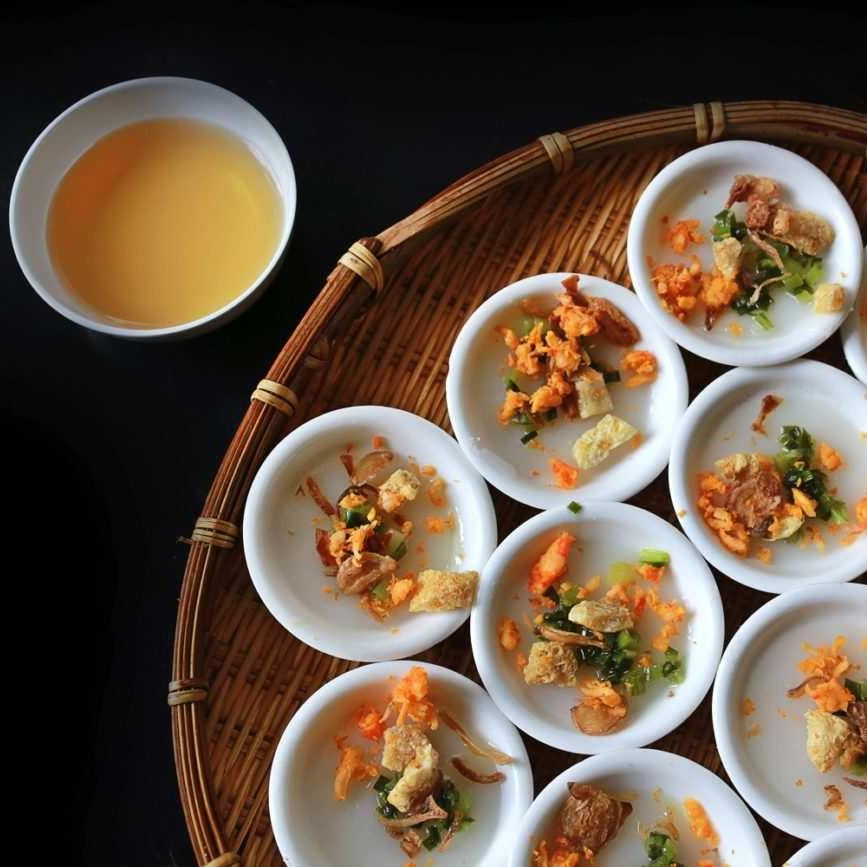
Hue cuisine is a heart that characterizes central Vietnamese cuisine. The city features a strong focus on vegetarianism, so there are many all-vegetarian restaurants scattered throughout the city. Most of the locals follow a traditional belief of Buddhism to eat a vegetarian meal twice a month. Besides, another highlight that differentiates Hue cuisine from other regional cuisines of Vietnam is the small amount of food served. Rather, the key lies in the beautiful presentation, due to the royal cuisine influences. Taste and aesthetics are well combined in most Hue dishes, which were once explained to please the Nguyen feudal lords’ appetites. What’s more, the local food is often quite spicy. Hue food tours are among the best-selling packages, which cover a visit to the local market to buy the fresh ingredients and enjoy the cultural experiences on the spot. Then, participants will gather at a restaurant to join the live cooking class in which they are expected to perform the hands-on cooking. After the class, people will enjoy their food, receive comments, and get the recipes home for later practice.
For a typical Hue culinary tour, you will enjoy an early departure to Dong Ba Market for a glimpse of the local activities and products. The fresh market atmosphere in the morning is interesting. After wandering rounds, you will have breakfast with Hue beef noodle soup using Vietnamese chopsticks. Next, the tour will go on with a cyclo tour on the historical Trang Tien Bridge. The three-wheel vehicle will take you across the local streets, shops, and houses. Expect a nice view over the charming Perfume River. Then, you will arrive at the designated restaurant for a live cooking class. During class time, listen to a commentary on Hue gastronomy and the ingredients to be used. The chefs will show you the how-to, and then you carry on the steps to make the food. Options can be the spring roll, grilled beef, pancake, or banana flower salad. In the end, you will enjoy the food made by you and the one prepared by the restaurant.
Introduction to Hue Food
Mussel Rice
Mussel rice or “Com Hen” is a pride of the Hue cuisine and a must to eat. The food comprises rice, mussel, grease, onion, peanut, and several kinds of herbs. The original version of the Hue mussel rice can be found in the Hen islet on the Perfume River, and there are other versions across the city, which are still good to try. A note is that the mussel rice is spicy because its bowl always has some chilis. The food was once only to serve the emperors and their families. Nonetheless, nowadays, it has been so popular that people can even cook “Com Hen” at home. During the iconic tours to Hue, the mussel rice is a must you should always check the taste. The mussel boiling water can be added with slices of ginger for a favorable taste. Other versions are the mussels served with rice vermicelli or mussel porridge.
Hue Beef Noodle Soup
As traditional as mussel rice, Hue beef noodle soup is another pride of the local people. The food is very famous across the city, and even in other cities (Ho Chi Minh City, for example). Foodies love slurping the noodle soup filled with beef, herbs, etc., and especially the special soup. You might even enjoy it till the last drops. A typical bowl of “Bun Bo Hue” includes noodles, beef soup, vegetables, herbs, and slices of tender beef. It is the patron’s preference to ask for the parts of beef they like. Before you eat, try adding some drops of lime, slices of chili, and fresh vegetables into a bowl to mix them up. The delicious taste of Hue beef noodle soup is incomparable.
Steamed Rice Cakes
The steamed rice cake or “Banh Beo” is topped with minced shrimp, fried shallot, and mung bean paste. As an indispensable part of this table delicacy, the well-spiced dipping fish sauce plays an important role that can even decide the success of the food. The steamed rice cake is a portion of popular street food in Hue, which you can have for breakfast, lunch, or dinner. A bowl of Hue steamed rice cakes should be served hot. Then, you enjoy the soft taste of the rice, the sweet taste of the shrimp-and-pork fillings, and the aromatic smell of the shallots.
Hue Tapioca Dumplings
Tapioca dumplings or “Banh Bot Loc” is a small and clear-looking dumpling cake of Hue that can be served as appetizers or snacks. Inside the layer of leaves are sticky cakes, in which you can see the filling of shrimp and pork. The cake dough layer is chewy and sweet, which is perfect to be mixed with the little sweet and spicy fish sauce. Topped over the cakes are green spring onions for a beautiful presentation. From the first taste of the cakes, you know you might order more.
Pork Grilled on Lemongrass Stick
The locals call it “Nem Lui” which includes sticks of the grilled pork served on a tray together with the rice vermicelli, slices of cucumber, vegetables, pickles, carrot, and rice paper. Lied in the center of the tray is the dipping fish sauce (or shrimp paste). There are ways to eat this kind of sausage, but oftentimes, people enjoy adding all components into a bowl and showering them with the fish sauce. Or, you can try rolling every element onto the rice paper, make rolls, and dip them into the sauce.
Vietnamese crepe
Its Vietnamese name is “Banh Khoai”, which is a crepe made of rice flour and filled with pork, egg, minced shrimp, chili, carambola fruit, etc. The deep-fried crepe provides a crunchy taste. You can describe it as the mini-pancake or the modified form of the pancake. The complex should be dipped into the well-spiced fish sauce containing pork liver. The complex can also be served with Vietnamese mint, lettuce, starfruit, and other veggie leaves. Some foodies order couples of crepe cakes in Hue as they enjoy the crispy taste very much.
Hue sweet soups
Hue is famous for a variety of sweet soups and each kind has a delicious taste made from lotus seed, green bean, taro, etc. It’s an awesome culinary experience to enjoy cups of Hue sweet soups on the streets and in the small alleys. The colorful presentation and yummy sweetness of this enjoyable street food strongly appeal to foodies and patrons who are keen on the sweet taste. Upon your visit to a local booth of Hue sweet soup, you’ll be amazed by a wide range of choices, of which each is attractive and delectable. There will be some moments when you want to eat all kinds of “Che Hue.”
Am Phu Rice
“Am Phu” rice is a delicious dish with a strange and unique name, which ignites curiosity. Its origin is from a local restaurant named “Am Phu” on the Nguyen Thai Hoc Street, nearby Hue stadium. The restaurant is only open in the evening and uses the old oil lamps to give light, which results in its name for decades. A plate of Am Phu Rice is quite attractive with seven colors and prepared in artistic decoration. The An Cuu rice is put in the middle and surrounded by pork belly, shrimp, Hue spring rolls, sausage, omelets, slices of cucumber, herbs, etc. When you eat the food, soak the fish sauce on the top to enhance the taste. This food is popular in Hue, from street vendors to luxury restaurants. Check the menu to see if it has Am Phu Rice and then order one plate.
Introduction to Hue Future Orientation
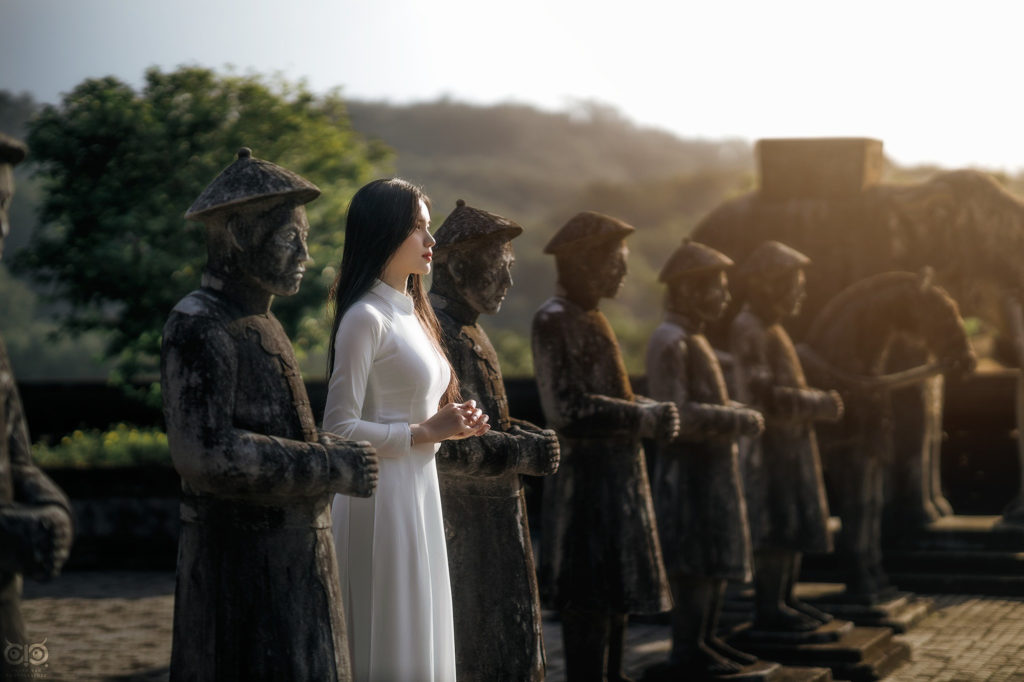
The future of Hue tourism is to apply technology to its development. The aims are to approach customers, provide better customer service, reduce the cost, and improve business efficiency. With digital transformation, Hue tours have been widely advertised on the social media platforms like Facebook, TikTok, and Instagram. The new introduction to Hue ‘s less-known attractions receives a high number of views and reactions. In the system of royal monuments, the technology has been implemented, such as the audio guide in 12 different languages in the Citadel of Hue and the QR Code in the VN Guide application to enhance the visitors’ sightseeing trips. In particular, the Tomb of Emperor Tu Duc was included in the list of 30 relics that are 3D digitized by Google, which aids to increase the promotion effects. In September 2020, Tu Duc Tomb continued to receive a high ranking in terms of architecture, art, and history. The property was selected by Google together with other landmarks of the world, searched by the Augmented Reality (AR) technology. There have been even attempts and research to put the courts and royal activities at night using virtual reality technology for guests to study and mingle with the nightlife in the ancient palace. This summer 2022, the Festival Thuan An Beach is about to take place and attract participants who desire the exciting summer vacations. So, you see, Hue is not only about history tours but also the cultural tours and festivals.


Comments